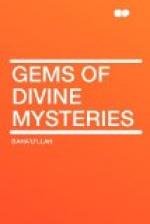Baha’u’llah
Gems of Divine Mysteries
Javahiru’l-Asrar
Baha’i World Centre
Baha’i world Centre copyright
(C)
2002 all rights reserved
Introduction
The decade-long exile of Baha’u’llah in ’Iraq began under the harshest of conditions and at the lowest ebb in the fortunes of the Babi Faith. It witnessed, however, the gradual crystallization of those potent spiritual forces which were to culminate in the declaration of His world-embracing mission in 1863. In the course of these years, and from the city of Ba_gh_dad, there radiated, Shoghi Effendi writes, “wave after wave, a power, a radiance and a glory which insensibly reanimated a languishing Faith, sorely-stricken, sinking into obscurity, threatened with oblivion. From it were diffused, day and night, and with ever-increasing energy, the first emanations of a Revelation which, in its scope, its copiousness, its driving force and the volume and variety of its literature, was destined to excel that of the Bab Himself."(1)
Among these early effusions of the Pen of Glory is a lengthy Arabic epistle known as the Javahiru’l-Asrar, meaning literally the “gems” or “essences” of mysteries. A number of themes it enunciates are also elaborated in Persian—through different revelatory modes—in the Seven Valleys and the Book of Certitude, those two immortal volumes which Shoghi Effendi has characterized, respectively, as Baha’u’llah’s greatest mystical composition and His pre-eminent doctrinal work. Undoubtedly the Gems of Divine Mysteries figures among those “Tablets revealed in the Arabic tongue” which were referred to in the latter volume.(2)
One of the central themes of the book, Baha’u’llah indicates, is that of “transformation”, meaning here the return of the Promised One in a different human guise. Indeed, in a prefatory note written above the opening lines of the original manuscript, Baha’u’llah states:
This treatise was written in reply to a seeker who had asked how the promised Mihdi could have become transformed into ’Ali-Muhammad (the Bab). The opportunity provided by this question was seized to elaborate on a number of subjects, all of which are of use and benefit both to them that seek and to those who have attained, could ye perceive with the eye of divine virtue.
The seeker alluded to in the above passage was Siyyid Yusuf-i-Sihdihi Isfahani, who at the time was residing in Karbila. His questions were presented to Baha’u’llah through an intermediary, and this Tablet was revealed in response on the same day.




